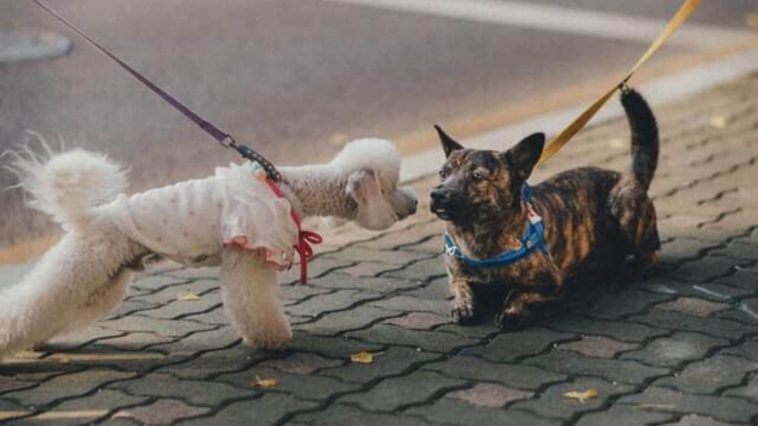Introducing a new puppy to your older dog is easier than you think! I’m going to show you how to introduce your dog to a new puppy in 9 simple steps. You’ll be surprised how well it works.
When you decide to get a new pet, it can be very difficult to know exactly how to introduce them to your dog. Dogs can act aggressively out of fear or territorial instincts. This article will help you to know how to introduce your dog to a new puppy.
How To Introduce Your Dog To A New Puppy
The first few days of living with a new puppy can be chaotic and confusing. The new puppy is excited, the older dog is nervous and it’s up to you to make sure everyone gets along.
It can be stressful for both you and your dog if you don’t know what to expect in terms of their behavior. Here are some tips on how to introduce your dog to a new puppy:
Step 1: Start early, with the right temperament.
The best time to introduce a new puppy into the family is when your older dog is still young and not set in his ways. If you’re starting with an older dog, see if he will accept the new puppy by having them interact in neutral territories, such as a park or dog daycare facility.
Step 2: Prepare the area
Set up a room in your house that is off-limits to your older dog. This should be a place where your new puppy can explore and get comfortable without being in danger from your older dog.
Step 3: Feed the pups separately
Feed both pups at separate times and put them on opposite sides of the room when they are eating. This will help keep them from seeing each other as competition for food, which could cause aggression. You can also feed them from different bowls so there’s less competition for food between them.
Step 4: Keep track of who’s eating what
Once both dogs are eating well individually, start giving them the same food at the same time to see how they react together. If one pup becomes aggressive toward the other while eating, separate them again until they calm down before trying again later on in the day or even another day if necessary.
The first thing to remember is that this is not a competition. The second thing is that your new puppy is going to be an absolute terror for the first few weeks.
Step 5: Take things slowly
Take things slowly, using lots of treats and praise when they are calm and relaxed around each other rather than trying to push them into meeting one another before they are ready or comfortable with it!
Step 6: Teach the puppy some commands
Train Fido from day one to be friendly toward other dogs in your family by rewarding his good behavior whenever possible so he learns what it means when you say “good boy.”
Step 7: Slowly integrate them together in your house
Put them in separate rooms at first – don’t let them see each other yet! Put their beds in different rooms so they can hear each other but cannot get close enough for a good sniffing session until you say so.
Step 8: Set up their first meeting carefully
If your older pet has never met a puppy before, the first time they meet should be in a neutral location, with plenty of treats and praise for both dogs involved.
Keep your older dog on his leash and supervised by at least one person at all times during this initial meeting so that he doesn’t feel threatened or run away from the new puppy.
Allow them to sniff each other through the fence/gate/cage door but don’t let them interact beyond that point until you’ve introduced them more formally later on.
If your older dog seems too frightened or aggressive around the puppy during this first encounter, consider hiring a professional trainer who can help you make sure that everyone gets along well before bringing them home together permanently.
Step 9: Start with supervised playtime
Once the dogs get used to each other in the same room, try letting them interact for brief periods under supervision. Don’t leave them alone until you know that they are comfortable with each other.
If either dog gets too rambunctious or overstimulated, call them back into their own space and try again later when they’re both calm and relaxed.
Don’t force playtime! You want both dogs to feel safe around each other forcing them into situations where they feel uncomfortable will make things worse by causing stress and anxiety rather than making things better by allowing them to bond through positive experiences together.
What to Do During the Initial Meeting?
Introductions should be done slowly. First, you should choose your timing carefully. If you’re bringing home a new puppy, don’t bring him home when your current dog is at his most active level of energy such as right after dinner or during playtime. Pick a time when both dogs are calm and relaxed: after dinner or before bed.
The next step is to let your older dog get used to the smell of the puppy without actually seeing it. Put them side by side so they get used to each other’s scent and then gradually move them closer together while they’re on leads.
If they start fighting, separate them again and try again later when they’ve calmed down. Don’t try this with puppies under five months old because they’re too young and boisterous for this kind of introduction process wait until they’re older before trying again.
Also, make sure that both dogs are vaccinated against distemper and parvovirus before introducing them because these diseases can spread very easily between dogs who haven’t been vaccinated against them yet.
You want both dogs to feel safe around each other forcing them into situations where they feel uncomfortable will make things worse by causing stress and anxiety rather than making things better by allowing them to bond through positive experiences together.
What you should do with your dog and new puppy?
One of the biggest mistakes people make when introducing their dogs to a new puppy is not taking enough time to do it correctly.
You must take your time and make sure that your older dog is comfortable with the new puppy before allowing them to interact together.
Here are some tips you should follow when introducing your dog to a new puppy:
1. Don’t rush things. It’s always best practice to introduce dogs slowly and gradually, especially if they’re going to be spending time together in the same house or yard at any point in the future.
This means that you don’t want to just throw them together and hope for the best instead, make sure that they’re getting along well with each other before letting them run loose together outside or sleep in the same room at night (or both).
2. Make sure they don’t feel threatened by each other’s presence. This means keeping them separated as much as possible until they’re more comfortable with each other, even if that means keeping one on a leash while letting the other roam freely around an enclosed area like an exercise pen (or inside).
3. Keep the new dog in its crate or a separate room until you’re sure they’ve bonded with each other.
4. Don’t allow either animal out of its crate until both are calm and relaxed around each other.
5. Take things slowly. Don’t expect much activity from either animal for at least 24 hours after meeting each other, especially if you’ve brought home a small puppy (under 6 months old).
Give them time to get used to each other’s scents and sounds before letting them romp together or play too roughly.
6. Don’t let dogs approach each other nose-to-nose or mouth-to-mouth until they’re comfortable doing so on their own terms this could lead to aggression between them.
How long does it take for a dog to get used to a new puppy?
The answer is it depends on the personalities of the dogs, but generally, anywhere from 1 week to 2 months. The younger the puppy, the faster your dog will accept him/her. It’s best if you can introduce your older pup to the new puppy when they’re both still young (under 6 months old). If they are older than 6 months old, you’ll probably have a longer adjustment period.
Some dogs are naturally more friendly than others, so they will warm up to the new pup faster than others. Some people also say that if you introduce them at an early age (before six months), it will go smoother than introducing them later in life.
However, even if you adopt your new dog when he or she is young or buy one from a reputable breeder, there’s no guarantee that he or she will like your new puppy. It’s possible that your older dog won’t recognize the puppy as part of his family and may even try to attack him.
Even if this happens, don’t give up hope yet! You can still teach your older dog to accept his new brother or sister and make sure that they’re safe around each other.
How do I get my older dog to accept a new puppy?
Congratulations on your new puppy! Your little bundle of joy is going to be a wonderful companion for both you and your older dog.
But, as you probably know, getting an adult dog to accept a new puppy can be challenging. Here are some tips for making the transition easier for everyone involved:
The first thing that needs to happen is for the older dog to get used to being alone. This may sound counterintuitive, but he must learn how to tolerate being left alone without getting overly anxious or destructive.
If he doesn’t have time alone during the day and evening, then he won’t be able to handle it when you leave him with the puppy overnight.
A crate is often recommended as an aid in getting this started. However, crates are not appropriate for all dogs, especially ones who are already anxious or nervous about being left alone.
Another option is a baby gate across the doorway between rooms or even just one side of the doorway if there’s enough space; however, this can be impractical if you need access through that doorway frequently throughout the day (such as when traveling between rooms).
Will my dog get jealous of a new puppy?
You’ve decided to get a new puppy, and you’re wondering what your current dog will think of this new addition to the family. You may be wondering whether or not your dog will become jealous, or if he’ll feel threatened by this sweet little puppy.
In most cases, introducing a new puppy into a household with an older dog can be a positive experience for both dogs. But there are some things you should know before bringing home that new bundle of fur.
Your dog may be feeling threatened by the presence of a new puppy, but there are things you can do to help him adjust.
The first step is to make sure that your dog is physically healthy. An annual checkup by your veterinarian will include a physical exam and blood work to determine if your dog has any underlying medical conditions that could be affecting his behavior. If he’s in good health, then it’s time to do some training!
Make sure your older dog knows that you love him or her and have a special place in your heart for this wonderful canine companion.
Understand that you may need to start over with step one several times per day, every day until your older dog relaxes and learns to accept the new puppy as part of the family.
Things To Consider Before Getting a Puppy
Dogs can become territorial and protective over their space, especially if you’re adding a new puppy to the family.
Make sure the new addition is healthy and vaccinated before bringing it home, so you don’t expose your current pup to any harmful diseases.
Puppies are adorable, but they can be a lot of work! If you’re considering adding a puppy to your family, make sure you’ve considered the following:
Is My Dog Ready For A Puppy?
Does my dog get along with other dogs? Is he or she friendly and welcoming? If not, consider working with a trainer to help socialize your dog before bringing home the new puppy. Be sure to keep an eye on them at all times during the introduction process so that neither gets hurt.
How Will I Handle It If My Current Dog Doesn’t Like The New One?
If your dog isn’t accepting of the new puppy at first, it’s important not to force them together until they’ve had time to adjust and get used to each other’s scents and sounds.
Even if you have an older dog who may have an easier time adjusting, remember that puppies require lots of attention which means less time for your dog!
Does your older dog like puppies in general?
Some dogs just don’t like puppies at all and others have issues with specific breeds of dogs (such as small fluffy ones).
If your dog has never been around puppies before, it’s best to introduce them slowly and carefully so there’s no chance of any injuries or fights between the two dogs.
Is there an age gap between the two dogs?
Introducing older dogs to younger ones is much easier than introducing young ones. Puppies tend to be more energetic than adults so if there’s an age gap between the two pups, it could be even more difficult for them to get along if they’re both very active.
The Right Age for a Puppy
You can get a puppy at any age, but if you’re looking for a companion animal, it’s best to get one when it is between eight and 16 weeks old. At this point, the puppy has had its first set of vaccinations and has learned the basics of house training.
It’s also important to note that puppies may not be ready for adoption until they are at least eight weeks old.
This is because puppies are born blind and deaf, and they need time to develop those senses before they can be placed in homes with other pets or children.
Young puppies also need time with their mother and littermates to learn proper socialization skills.
What Kind of Puppy Do You Want?
Puppies come in all shapes and sizes! Different breeds have very different characteristics some are more active than others; some are better suited for apartment life; some require more grooming than others; some may shed more than others so you must choose a breed that fits your lifestyle!

In Conclusion
Never forget that your dog is afraid and that if you don’t act quickly, he may feel trapped between his old territory and the new baby.
You may have to hold him for a few hours until he settles in again, with the doors closed to his old territory.
If he does go on the furniture, simply show him that this is not where he sleeps. Perhaps provide a bed or crate for him with a blanket inside, so he has a place of his own, which will anchor him through this chaotic time.
Just follow these simple steps to make the dog-dog introductions a breeze. You’ll find that, with a little patience and persistence, you’ll have the puppies playing together in no time flat.
Hopefully, this guide on how to introduce your dog to a new puppy will help you and give you a leg up.
Ultimately, there’s no right or wrong way to introduce dogs, as long as they remain friendly with each other and they receive sufficient attention and love from their owners. Good luck!
Anything To Add About:
Like the article how to introduce your dog to a new puppy? Have a point of view to share? Let us know! Share your training tricks below!
Please feel free to ask any questions you may have about purchasing a puppy, owning a dog, training, or anything else related to pets.
How To Teach A Puppy To Lay Down | Simple Steps To Train Your Dog
How To Walk A Dog That Pulls – Strategies to Teach your Dog
How to Socialize Your Dog With Other Dogs and Humans



